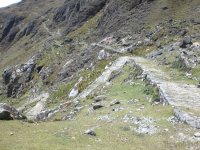I wonder if everyone studied the pic posted at the beginning? Some are stating the dozer established the basic roadbed. Well, with more than just a glance at the pic it becomes very obvious all the dozer did was cut into the hillside and let the tailings fall off the lower side. Created a clay base on the left side, top soil embedded with roots and debris on the right side. Basically a flat surface. Modest position for the Excavator to work from at best.
Eddie gave a very good description of what's needed for a drainage area on the uphill side. It most certainly doesn't need a "V ditch". I described it as something your tractor can fit in. Kinda freaked some posters out. They thought I was building a "hiway". I wasn't referring to the road surface. I was referring to the drainage area that can then be maintained as described by Eddie.
Pictures of roadways on basically flat surfaces have no relevance to what's posted in the picture by the OP.
Pictures of rear blades cutting sod have no relevance to what's posted in the picture by the OP.
Again I stress, the OP is going to use this roadway every day. Properly built it will only require occasional light maintenance and rarely need additional gravel. By rarely I mean every 10 years or so. Poorly built it will require maintenance during and after every rainy season and yearly additional gravel. By yearly I mean a stockpile of gravel will be needed onhand so it can periodically be added to the areas that have substandard drainage.
I maintain 50 miles of gravel roadways. The portions that have inadequate drainage require constant maintenance. The portions that are properly constructed with appropriate drainage require minimal maintenance and never need additional gravel beyond the annual dose of 65 ton per mile. Before you jump all over that requirement think for a minute. I'm talking about public roadways that handle 80,000 semis loaded with grain. Worse yet they handle 30ft GN stock trailers with single tires stuffed full of cattle.
My described experiences in road building and maintenance certainly don't make me an expert. My methods of construction and/or maintenance might be ridiculed by some. But my knowledge and experience concerning roadbed elevation and proper drainage cannot be disputed.
Remember what I said earlier. A road without ditches is a ditch.




